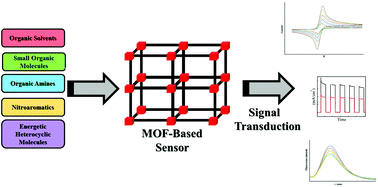Sensing organic analytes by metal–organic frameworks: a new way of considering the topic
Abstract
Three-dimensional porous coordination polymers, which are known as metal–organic frameworks (MOFs), have drawn considerable attention owing to their properties, such as highly crystalline and ordered structures, inorganic–organic-hybrid nature, tunability of chemical functionality, high porosity and surface area and moderate-to-high stability. Due to these properties, MOFs are applied extensively as probes for the detection of large varieties of organic molecules. In this line, different MOF-based instrumental and material-based methods along with different strategies have been developed to study and extend our information about the capabilities of MOFs as sensing probes for the detection of organic molecules as well as improving and developing their detection limits, selectivity and sensitivity toward specific analytes. Considering these points, we have presented and classified the content of this review based on the chemical structures of organic analytes in three categories, including (I) nitroaromatic explosives and energetic materials, (II) small organic molecules, such as solvents and volatile organic compounds, and (III) organic amines. For each group of these analytes, different material and instrumental methods using MOFs have been explained, with illustrations of remarkable examples. Finally, we compare the methods for the detection of each group of analytes and discuss which instrumentation is more effective for each group of analytes.

- This article is part of the themed collection: 2020 Inorganic Chemistry Frontiers Review-type Articles


 Please wait while we load your content...
Please wait while we load your content...